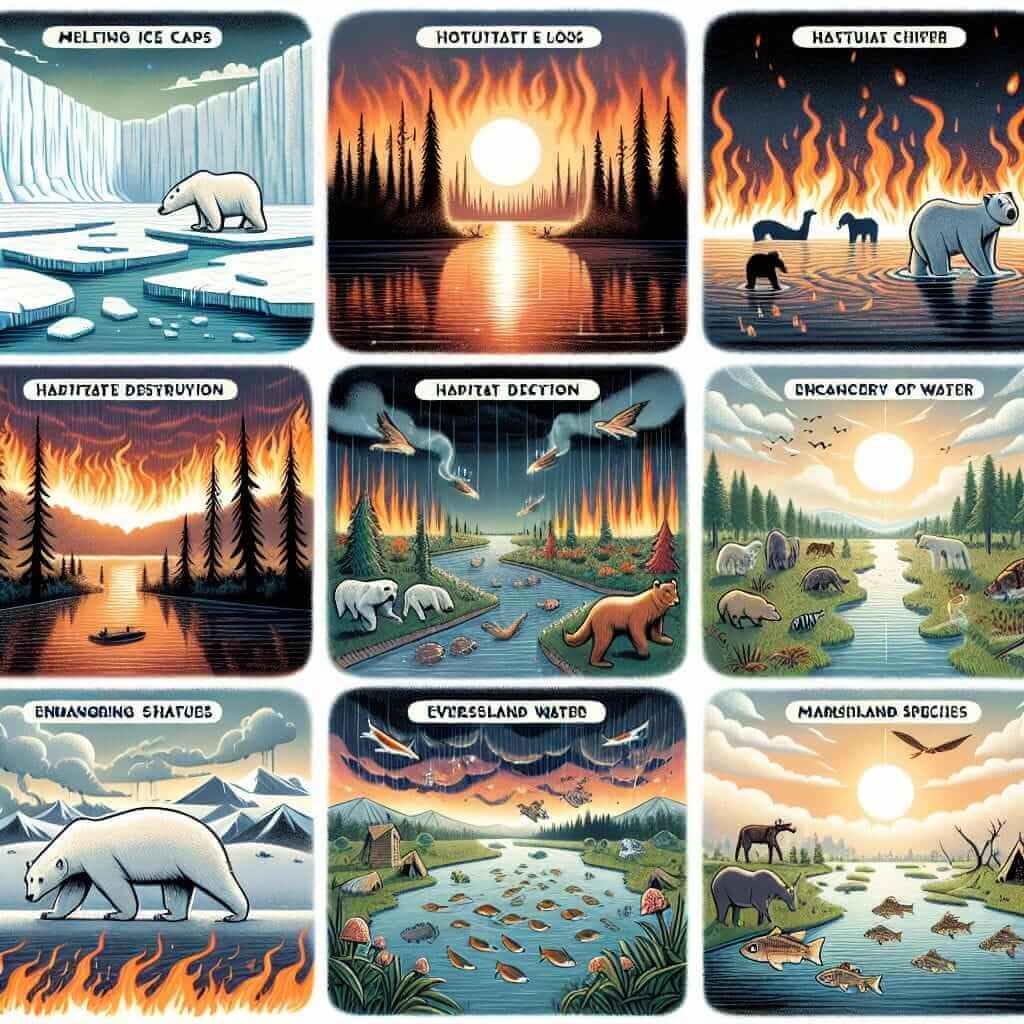The IELTS Reading section tests a candidate’s ability to read and comprehend academic texts. A popular topic for the Reading section involves understanding the implications of climate change, which is a recurrent theme due to its global relevance and frequency in IELTS exams. Given the increasing urgency of climate change issues, the likelihood of encountering this topic in future IELTS tests is high.
In this article, we will explore the implications of climate change for biodiversity, providing a comprehensive reading passage, questions, and answer keys, along with vocabulary and grammar tips to help you excel.
Reading Passage: “The Implications of Climate Change for Biodiversity”
Reading Passage (Medium Text)
Climate change refers to significant changes in the global climate patterns, primarily caused by human activities such as burning fossil fuels and deforestation. These activities increase the concentration of greenhouse gases in the atmosphere, leading to global warming and other climate anomalies.
One of the critical impacts of climate change is on biodiversity—the variety and variability of life on Earth. The consequences of climate change for biodiversity are profound and multifaceted. Temperature increases, altered precipitation patterns, and extreme weather events have far-reaching effects on ecosystems and species.
Firstly, rising temperatures can disrupt species’ habitats. Many plants and animals are adapted to specific temperature ranges, and an increase in temperature can make their current habitats inhospitable. For instance, polar species such as the polar bear are highly vulnerable as their ice-covered habitats shrink. Similarly, coral reefs, which host a quarter of all marine species, are at risk due to ocean warming and acidification.
Secondly, changes in precipitation patterns affect the availability of water resources, impacting species’ survival. Regions that become drier may no longer support certain plant and animal life. Conversely, increased rainfall in some areas can lead to flooding, disrupting habitats and food sources.
Moreover, extreme weather events such as hurricanes, wildfires, and droughts are becoming more frequent and intense due to climate change. These events cause direct harm to plant and animal life, destroy habitats, and prompt mass migrations. For example, wildfires not only obliterate forests but also release large amounts of CO2, exacerbating the climate crisis further.
Additionally, the timing of natural events such as blooming, breeding, and migration is being altered. Species that cannot adapt quickly enough may face extinction. The interdependence of ecosystems means that the loss of one species can have cascading effects on others, potentially leading to widespread biodiversity loss.
In conclusion, the implications of climate change for biodiversity are alarming. Urgent action is required to mitigate these impacts by reducing greenhouse gas emissions and implementing conservation strategies to protect vulnerable species and ecosystems.

Questions and Answers
Questions
-
Multiple Choice: What is the primary cause of climate change?
A. Natural climate cycles
B. Human activities
C. Alien interventions
D. Volcanic eruptions -
True/False/Not Given: Rising temperatures could cause some species to lose their habitats.
- True
- False
- Not Given
-
Matching Information: Match the following climate-related impacts with their consequences on biodiversity.
- A. Rising temperatures
- B. Altered precipitation patterns
- C. Extreme weather events
i. Disrupts water availability
ii. Destroys habitats and prompts migrations
iii. Makes current habitats inhospitable -
Sentence Completion: Coral reefs are at risk due to and .
-
Summary Completion: Fill in the blanks:
Climate change impacts biodiversity in numerous ways. Rising temperatures make current habitats for species, altered precipitation affects , and extreme weather events ____ habitats.
Answer Key and Explanations
-
Multiple Choice: B. Human activities
- Explanation: The passage states that climate change is caused primarily by human activities such as burning fossil fuels and deforestation.
-
True/False/Not Given: True
- Explanation: The passage mentions that rising temperatures can make current habitats inhospitable, leading to the loss of habitats for some species.
-
Matching Information:
- A. Rising temperatures – iii. Makes current habitats inhospitable
- B. Altered precipitation patterns – i. Disrupts water availability
- C. Extreme weather events – ii. Destroys habitats and prompts migrations
-
Sentence Completion: Coral reefs are at risk due to ocean warming and acidification.
- Explanation: The passage highlights that coral reefs face threats from both ocean warming and acidification, which are direct results of climate change.
-
Summary Completion: Climate change impacts biodiversity in numerous ways. Rising temperatures make current habitats inhospitable for species, altered precipitation affects water resources, and extreme weather events destroy habitats.
- Explanation: These blanks are filled in based on the comprehensive effects described in the passage.
Common Mistakes
- Misinterpreting the cause and effect relationships outlined in the passage.
- Skimming too quickly, leading to overlooked details that are crucial for answering questions correctly.
- Confusing similar-sounding terms like “precipitation” and “temperature.”
Vocabulary
- Biodiversity (noun) /ˌbaɪ.oʊ.dɪˈvɜː.sə.ti/: The variety of plant and animal life in a particular habitat.
- Greenhouse gases (noun) /ˌɡrin.haʊs ˈɡæs.ɪz/: Gases that trap heat in the atmosphere, contributing to global warming.
- Inhospitable (adjective) /ɪnˌhɒsˈpɪt.ə.bəl/: Unwelcoming or unsuitable for living.
- Acidification (noun) /ˌæs.ɪ.dɪ.fɪˈkeɪ.ʃən/: The process of becoming more acidic.
Grammar Focus
- Passive Voice: Used to emphasize the action rather than who is performing it. E.g., “Many plants and animals are adapted to specific temperature ranges.”
- Complex Sentences: Combining multiple ideas into one sentence to show relationships clearly. E.g., “Extreme weather events such as hurricanes, wildfires, and droughts are becoming more frequent and intense due to climate change.”
Tips for High Reading Scores
- Practice Regularly: Consistent practice with various texts can help improve comprehension speed and accuracy.
- Understand Question Types: Familiarize yourself with different types of questions (e.g., True/False/Not Given, Summary Completion) to know what to expect.
- Skim and Scan: Develop skimming (reading quickly) and scanning (looking for specific information) techniques to save time.
In conclusion, understanding the implications of climate change for biodiversity not only enhances your knowledge but also prepares you for potential IELTS Reading topics. By practicing with similar passages and honing your reading strategies, you can achieve a high score in the Reading section.